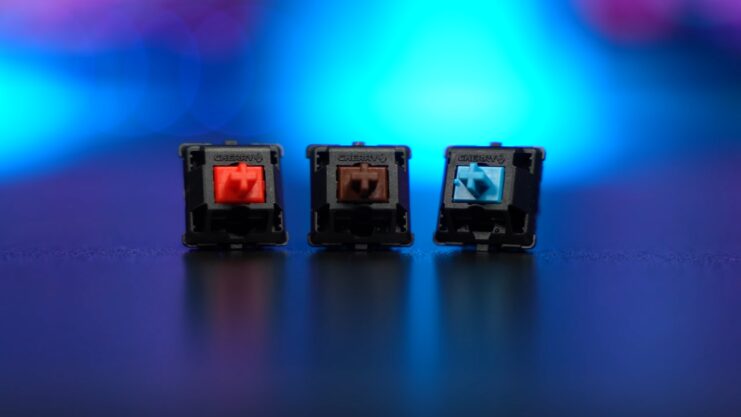Choosing the right mechanical keyboard switch can be a game-changer for both typing and gaming. I’ve had the opportunity to test all three popular Cherry MX switches: Red, Blue, and Brown. Each switch has its unique characteristics and appeals to different users.
I’ll break down the differences between these switches, discussing their pros and cons based on firsthand experience.
Key Takeaways
- Whether you’re a hardcore gamer, a dedicated typist, or someone who juggles both, there’s a Cherry MX switch for you. Reds for lightning-fast gaming, Browns for a satisfying middle ground, and Blues for that classic typist feel.
- It’s all about what clicks for you. For me, Browns are the sweet spot, offering tactile feedback without the noise. But hey, your fingers might tell a different story.
- Once you go mechanical, it’s hard to go back. The feel, the sound, the durability – it’s not just typing, it’s an experience. And who knew keyboard clicks could be so relaxing?
Cherry MX Red Switches
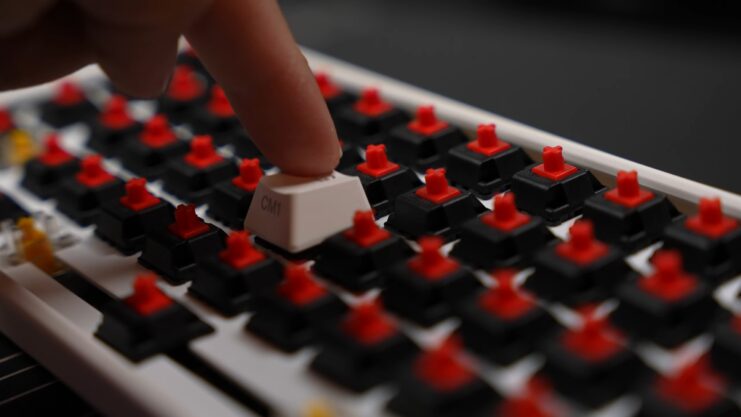
If you’re all about fast-paced gaming, Cherry MX Red switches are the way to go. Their light touch and smooth actuation make them ideal for quick reflexes and rapid key presses.
The lack of tactile bump and silent operation can be a double-edged sword, depending on your preferences. For typists, this might not be the best choice due to the potential for accidental keypresses.
However, for gamers who prioritize speed and quiet operation, these switches are a dream come true. Gaming with Cherry MX Red switches is a smooth experience.
The keys respond instantly with minimal force, allowing for quick and effortless keystrokes. This is a game-changer during intense gaming sessions, where speed and response time are crucial.
The quiet nature of these switches also means late-night gaming without disturbing anyone, a significant plus in my book.
The downside? The lack of tactile feedback can lead to accidental keypresses, especially when typing at speed. It’s something you can get used to over time, but it’s definitely a factor to consider if you’re planning to use the keyboard for both gaming and typing.
| Type | Linear |
| Actuation Force | 45g (Light) |
| Tactile Feedback | None |
| Audible Click | None |
| Travel Distance | 2mm to actuation, 4mm total |
Cherry MX Brown Switches
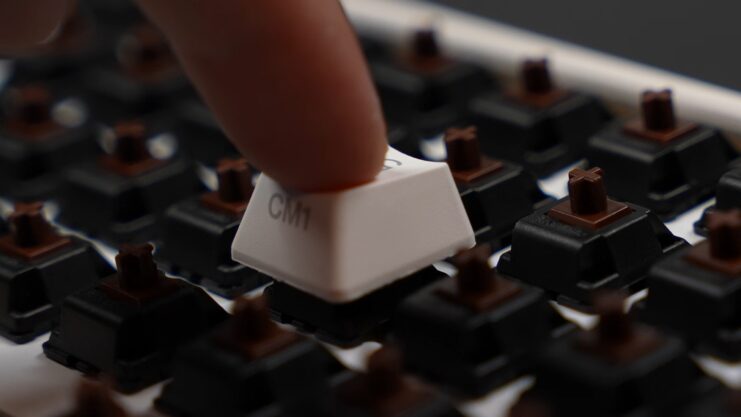
My time with Cherry MX Brown switches has been a blend of satisfaction and adaptability. The tactile feedback they provide is just right – noticeable enough to confirm each keystroke without being overly pronounced.
This makes them excellent for typing, offering a sense of precision and control. When gaming, these switches feel responsive and reliable, though not as fast as the Reds. Cherry MX Brown switches are an excellent all-rounder.
They provide enough tactile feedback to satisfy typists while being quiet enough for use in any environment. These switches are particularly well-suited for those who don’t want the loud click of Blues but desire more feedback than what Reds offer.
| Type | Tactile |
| Actuation Force | 45g – 55g (Medium) |
| Tactile Feedback | Yes, mild tactile bump |
| Audible Click | No |
| Travel Distance | 2mm to actuation, 4mm total |
Cherry MX Blue Switches
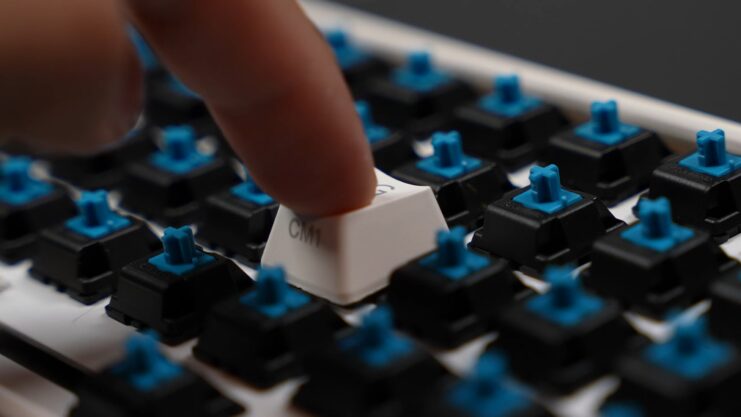
Cherry MX Blue switches stand out for their distinct tactile and auditory feedback. They offer a very satisfying typing experience that is often preferred by those who spend a lot of time on keyboards.
The feedback you get from each keypress is both felt and heard, which many find beneficial for accuracy in typing. However, they’re not for everyone. The clicky sound, while enjoyable for some, can be a distraction in quiet environments or shared workspaces.
In gaming, the tactile bump and additional actuation force can slightly slow down the keystroke response, which might not be ideal for fast-paced games.
| Type | Clicky |
| Actuation Force | 50g – 60g (Medium-High) |
| Tactile Feedback | Yes, pronounced tactile bump |
| Audible Click | Yes |
| Travel Distance | 2.2mm to actuation, 4mm total |
How to Make The Right Choice?
Selecting the right mechanical keyboard switch is a personal journey, as it largely depends on your typing style, noise preference, and what you primarily use your keyboard for.
- Cherry MX Red: These are a gamer’s best friend. Their light actuation force and linear feel make them ideal for fast-paced gaming. However, for typing, they can lead to more typos due to the lack of tactile feedback.
- Cherry MX Brown: Browns strike a perfect balance for me. They offer enough tactile feedback for typing without being too loud. This makes them versatile for both gaming and typing. The tactile bump is satisfying, yet not as pronounced as the Blues, which I find ideal for prolonged use.
- Cherry MX Blue: The tactile and audible feedback of Blue switches is unmatched. They are excellent for typing, providing a satisfying click and bump with each keystroke. However, they can be loud, which might not be ideal in shared spaces. For gaming, the tactile bump can be a bit of a hindrance for rapid key presses.
Personal Favorite: My favorite has to be the Cherry MX Brown switches. They offer the best of both worlds – the tactile feedback that aids in typing accuracy and a quieter operation suitable for any environment. Their versatility is a significant factor, making them adaptable for various tasks, from gaming to writing lengthy documents.
| Switch Type | Actuation Force | Feedback Type | Noise Level | Best For |
|---|---|---|---|---|
| Cherry MX Red | 45g (Light) | Linear | Quiet | Gaming |
| Cherry MX Brown | 45g – 55g (Medium) | Tactile | Moderate | Typing and Gaming |
| Cherry MX Blue | 50g – 60g (Medium-High) | Clicky | Loud | Typing |
Why Are Mechanical Keyboards So Popular?
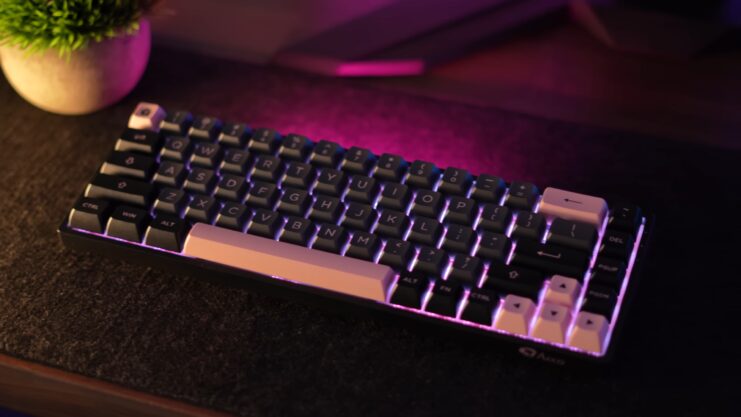
You know, there’s something undeniably alluring about mechanical keyboards that’s hard to put into words until you’ve used one. It’s like the difference between writing with a standard pen and a high-quality fountain pen – the experience is just on another level.
From the moment I first typed on a mechanical keyboard, I was hooked, and I think many share this sentiment. The tactile feedback is a big part of the appeal.
Whether it’s the smooth glide of Cherry MX Reds, the satisfying bump of Browns, or the clicky, tactile response of Blues, there’s a physical connection to the device that membrane keyboards just can’t match. It’s not just about pressing keys; it’s about feeling every keystroke, which adds a level of satisfaction to typing that’s hard to describe.
Durability is another huge factor. Mechanical keyboards are built to last. We’re talking about keys that can withstand tens of millions of presses without losing their feel or responsiveness.
In a world where we’re used to replacing tech every few years, a good mechanical keyboard can be a decade-long companion. It’s a worthwhile investment, especially if you spend a lot of time at your computer.
Then there’s customization. You can swap out keycaps, modify switches, and even play around with lighting to make your keyboard truly yours. It’s not just a tool; it’s a personal statement.
This aspect of personalization and the DIY culture around mechanical keyboards create a community of enthusiasts who share tips, designs, and experiences.
And, of course, the sound. There’s something oddly satisfying about the click-clack of a mechanical keyboard. It’s a sound that can be strangely soothing or invigorating, depending on who you ask.
Did you know that the sound of mechanical keyboards has become so popular that there are entire YouTube channels and social media pages dedicated to it? It’s a phenomenon called ASMR.
https://www.youtube.com/watch?v=Qr3nYR15wxU&pp=ygUhd2h5IG1lY2hhbmljYWwga2V5Ym9hcmQgaXMgYmV0dGVy
FAQs
Is blue switch good for FPS games?
Blue switches are not ideal for FPS games because they are clicky and loud, which can be distracting and annoying for you and others. They also have a high actuation force and a noticeable bump, which can slow down your keystrokes and reduce your accuracy.
Do switches really matter for gaming?
Switches do matter for gaming because they affect the feel, speed, and sound of your keyboard. Different switches have different characteristics, such as linear, tactile, or clicky, and different actuation force, travel distance, and debounce time. Depending on your personal preference and the type of game you play, some switches may suit you better than others.
Which mechanical switch is the quietest?
The quietest mechanical switch is the Cherry MX Silent Red, which is a linear switch with rubber dampers on the stem to reduce the noise of the bottom-out and upstroke. Other quiet switches include the Gateron Silent Red, the Durock Silent Linear, and the ZealPC Healio.
Should I lube Cherry MX Brown?
Lubing Cherry MX Brown switches can improve their smoothness and reduce their scratchiness, but it requires desoldering the switches and applying a thin layer of lubricant on the stem and the housing. Lubing can also change the sound and the tactility of the switches, so it may not be worth the effort and the risk of damaging the keyboard.
Last Words
In the end, the ‘best’ switch is a highly personal choice. It depends on what feels right under your fingers, what sounds good to your ears, and what suits your daily needs.
Don’t be afraid to experiment. It’s not just about what you type, but how it feels to type it. If you are a gamer, the right keyboard can make a difference, but the same is for other equipment like the hardware, monitor, and a chair.
Those spending hours while playing video games should check out the best gaming chairs for 2024.

